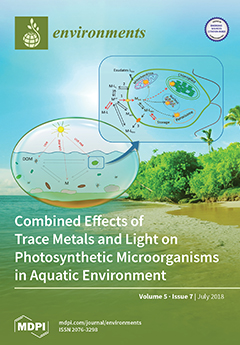Zinc (Zn) and arsenic (As) occur as mixed contaminants in soil and the interactions between them remain unclear. Here, we investigated a Zn
2+ and H
2AsO
4− mixture interaction and their effects on plant growth. Three different soils were spiked
[...] Read more.
Zinc (Zn) and arsenic (As) occur as mixed contaminants in soil and the interactions between them remain unclear. Here, we investigated a Zn
2+ and H
2AsO
4− mixture interaction and their effects on plant growth. Three different soils were spiked with ZnCl
2 and NaH
2AsO
4, each dosed singly or in combination. The soils were leached to remove excessive salt and were aged (>7 days), before toxicity testing using a 5-day root elongation of barley (
Hordeum vulgare L.). In the single treatments, the 50% inhibitory effect concentrations in the soil (
EC50, total measured concentration) were 2000–3800 mg Zn kg
−1 and 96–620 mg As kg
−1, depending on the soils. The mixture analyses based on the total concentrations showed overall and significant Zn–As antagonism in two soils, either based on the concentration addition (CA) or independent action (IA) model, whereas no significant interactions (either CA or IA) were found in one soil, which had the lowest content of Fe-oxides. The soil solution composition showed a decreased As concentration upon the addition of ZnCl
2 at an equal soil As total concentration; however, the reverse was not found, in line with the cation–anion electrostatic interaction or formation of ternary surface complexes on Fe-oxides. The data revealed that the Zn–As antagonisms (total concentrations) are partially related to the increased Zn immobilizing As in soil.
Full article





